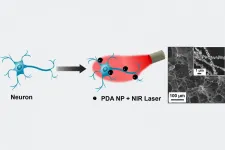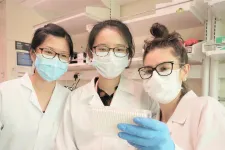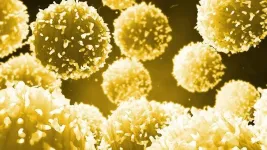(Press-News.org) Nanomaterials have been used in a variety of emerging applications, such as in targeted pharmaceuticals or to bolster other materials and products such as sensors and energy harvesting and storage devices. A team in the McKelvey School of Engineering at Washington University in St. Louis is using nanoparticles as heaters to manipulate the electrical activity of neurons in the brain and of cardiomyocytes in the heart.
The findings, published July 3, 2021, in Advanced Materials, have the potential to be translated to other types of excitable cells and serve as a valuable tool in nano-neuroengineering.
Srikanth Singamaneni, a materials scientist, and Barani Raman, a biomedical engineer, and their teams collaborated to develop a noninvasive technology that inhibits the electrical activity of neurons using polydopamine (PDA) nanoparticles and near-infrared light. The negatively charged PDA nanoparticles, which selectively bind to neurons, absorb near-infrared light that creates heat, which is then transferred to the neurons, inhibiting their electrical activity.
"We showed we can inhibit the activity of these neurons and stop their firing, not just on and off, but in a graded manner," said Singamaneni, the Lilyan & E. Lisle Hughes Professor in the Department of Mechanical Engineering & Materials Science. "By controlling the light intensity, we can control the electrical activity of the neurons. Once we stopped the light, we can completely bring them back again without any damage."
In addition to their ability to efficiently convert light into heat, the PDA nanoparticles are highly biocompatible and biodegradable. The nanoparticles eventually degrade, making them a convenient tool for use in in vitro and in vivo experiments in the future.
"When you pour cream into hot coffee, it dissolves and becomes creamed coffee through the process of diffusion," he explained. "It is similar to the process that controls which ions flow in and out of the neurons. Diffusion depends on temperature, so if you have a good handle on the heat, you control the rate of diffusion close to the neurons. This would in turn impact the electrical activity of the cell. This study demonstrates the concept that the photothermal effect, converting light into heat, near the vicinity of nanoparticles tagged neurons can be used as a way to control specific neurons remotely."
To continue the coffee analogy, the team has designed a photothermal foam that is similar to a sugar cube, forming a dense population of nanoparticles in tight packaging that acts more quickly than individual sugar crystals that disperse, Raman said.
"With so many of them packed in a small volume, the foam is quicker in transducing light to heat and give more efficient control to only the neurons we want," he said. "You don't have to use high-intensity power to generate the same effect."
In addition, the team, which includes Jon Silva, associate professor of biomedical engineering, applied the PDA nanoparticles to cardiomyocytes, or heart muscle cells. Interestingly, the photothermal process excited the cardiomyocytes, showing that the process can increase or decrease the excitability in cells depending on their type.
"The excitability of a cell or tissue, whether it be cardiomyocytes or muscle cells, depends to a certain extent on diffusion," Raman said. "While cardiomyocytes have a different set of rules, the principle that controls the sensitivity to temperature can be expected to be similar."
Now, the team is looking at how different types of neurons respond to the stimulation process. They will be targeting particular neurons by selectively binding the nanoparticles to provide more selective control.
INFORMATION:
It's hard to save what you can't identify. That's been a problem for the endangered salt marsh harvest mouse, which is found only in the salty, brackish waters of the San Francisco Bay area. The mouse competes for space with about eight million humans, and more than three-quarters of its habitat has been eaten by development and land conversion. That loss is expected to increase amid rising sea levels.
Conserving the population has proven tricky, in part because it looks so much like another mouse in the area--the western harvest mouse--that is abundant throughout western U.S.
But scientists from UC Davis have developed a tool, a "decision ...
Researchers from the Antimicrobial Resistance (AMR) Interdisciplinary Research Group (IRG) at Singapore-MIT Alliance for Research and Technology (SMART), MIT's research enterprise in Singapore, alongside collaborators from Biobot Analytics, Nanyang Technological University (NTU) and Massachusetts Institute of Technology (MIT), have successfully developed an innovative, open-source molecular detection method that is able to detect and quantify the B.1.1.7 (Alpha) variant of SARS-CoV-2. The breakthrough paves the way for rapid, inexpensive surveillance of other SARS-CoV-2 variants in wastewater.
As the world continues to battle and contain COVID-19, the recent identification of SARS-CoV-2 variants with higher transmissibility and increased severity has made the development ...
COLUMBUS, Ohio - The parasites that cause severe malaria are well-known for the sinister ways they infect humans, but new research may lead to drugs that could block one of their most reliable weapons: interference with the immune response.
In the study, scientists defined the atomic-level architecture of the connection between a protein on the surface of a parasite-infected red blood cell when it binds to a receptor on the surface of an immune cell.
When that protein-receptor connection is made under normal circumstances, the infected red blood cell, hijacked by the disease-causing parasite, de-activates the immune cell - meaning the body won't fight the infection. A drug designed to fit into that space could block the interaction, allowing the immune system to get to work clearing ...
LA JOLLA, CA--You can't make a banana split without bananas. And you can't generate stable regulatory T cells without Vitamin C or enzymes called TET proteins, it appears.
Regulatory T cells (Tregs) help control inflammation and autoimmunity in the body. Tregs are so important, in fact, that scientists are working to generate stable induced Tregs (iTregs) in vitro for use as treatments for autoimmune diseases as well as rejection to transplanted organs. Unfortunately, it has proven difficult to find the right molecular ingredients to induce stable iTregs.
Now scientists at La Jolla Institute for Immunology ...
DALLAS, July 21, 2021 -- Babies who were breastfed, even for a few days, had lower blood pressure as toddlers and these differences in blood pressure may translate into improved heart and vascular health as adults, according to new research published today in the Journal of the American Heart Association, an open access journal of the American Heart Association.
Research has found that cardiovascular disease risk factors, including high blood pressure, can start in childhood. Studies have also confirmed breastfeeding is associated with lower cardiovascular disease risk in adulthood. However, the amount and length of time breastfeeding that is needed ...
DALLAS, July 21, 2021 -- People who made even small increases in their daily physical activity levels after receiving an implantable cardioverter defibrillator (ICD) experienced fewer incidences of hospitalization and had a decreased risk of death, according to new research published today in Circulation: Cardiovascular Quality and Outcomes, an American Heart Association journal.
Implantable cardioverter defibrillators, also known as ICDs, are battery-powered devices placed under the skin that can detect abnormal heart rhythms and deliver an electric shock to restore a normal heartbeat. According to American Heart Association's Heart Disease ...
An international collaboration elucidates the mechanisms that facilitate accurate identification of moving images. The findings have been published in Nature Communications
Imagine meeting a friend on the street, and imagine that with every step they take, your visual system has to process their image from scratch in order to recognize them. Now imagine if the same thing were to happen for every object and creature that moves around us. We would live in a constant state of uncertainty and inconsistency. Luckily, that is not the case. Our visual system is able to retain information obtained in motion, thereby presenting us with a more consistent picture of our surroundings. These ...
Older adults may be slower to learn actions and behaviours that benefit themselves, but new research shows they are just as capable as younger people of learning behaviours that benefit others.
Researchers at the Universities of Birmingham and Oxford found that youngsters, in contrast, tend to learn much faster when they are making choices that benefit themselves.
The study, published in Nature Communications, focused on reinforcement learning - a fundamental type of learning in which we make decisions based on the positive outcomes from earlier choices. It allows us to adapt our choices to our environment by learning the associations between choices and their outcomes.
Dr Patricia Lockwood is senior author on ...
Every day, people are exposed to a variety of synthetic chemicals through the products they use or the food they eat. For many of these chemicals, the health effects are unknown. Now END ...
New research published in the European Journal of Clinical Investigation identifies cardiovascular test results that might help to identify patients hospitalized with COVID-19 who face an especially high risk of dying.
Out of 1,401 patients with a confirmed diagnosis of COVID-19 admitted to seven Italian centers, 226 (16.1%) underwent transthoracic echocardiography within 48 hours of admission. In-hospital death occurred in 68 patients (30.1%). Low left ventricular ejection fraction, low tricuspid annular plane systolic excursion, and acute respiratory distress syndrome were independently associated with in-hospital mortality.
"Clinical ...



